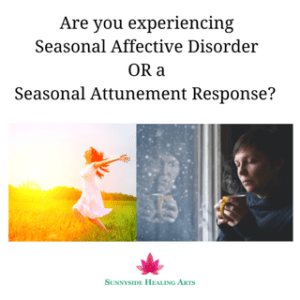
At this time of year, much is discussed about changes in mood and energy and it is generally attributed to Seasonal Affective Disorder. Given the medicalization and pathologization of our emotional states, which does not sit well with those who take a more holistic approach to wellness and healing, is this the proper way to understand the phenomenon? Or, is it possible that we are actually experiencing a response that is in line with our attunement to the nature, the environment and to seasonal shifts? We could refer to this as being connected to Seasonal Attunement Data or experiencing a Seasonal Attunement Response. Both of these concepts resonate more strongly than the suggestive nature that having mood and energy shifts that change seasonally is disordered.
When the days get shorter, the weather gets colder and vistas more bare, stark and grey, is it possible that our mood states are shifting right along with our environmental patterns? In the summer, with longer days, warmer weather and bright sunshine, many of us know what it’s like to experience an improved mood and outlook. It feels like Mother Nature is inviting outside to relax, enjoy, play and take in the energy of the sun.
In the winter, it’s like Mother Nature is asking us to stay indoors more and get quieter. What if the darker, colder days, which can elicit more challenging and uncomfortable emotions, are exactly how we are meant to feel? What if this is our opportunity to experience, investigate, process and soothe our difficult emotional states?? What if both of these scenarios are a reflection of our divine, innate attunement to the weather and our environment in a healthy way???
In the summer, we are drawn outside more and have the opportunity to absorb vitamin D, which is a major contributor to mood and has a half-life that can be very helpful in the transition to colder, darker climes. In most places on earth (save for around the Equator), vitamin D supplementation is encouraged to keep levels up to enhance physical, immune and emotional health. If we go through the seasonal shifts and use the winter to get cozy, stay in, listen to our emotional and cognitive states and use the downtime to experience, process and work through difficult issues that may not come up when we are overall more content and busy in the summer, we have the time and space to make meaning from this experience and use our extra time wisely.
Many seasonal shifts long ago when I was looking for a job, I recall that when the weather was nice and sunny, I felt more optimistic and hopeful. When the weather was grey or rainy, I felt sadder, less optimistic and less hopeful. It provided me an opportunity to take action when the energy was there and to feel, process and soothe the painful emotions that came up on the other days. Balance between the continuum or range of human emotional experiencing can happen in this way.
During the seasonal shift into winter, there are a few ways to manage from a holistic approach. This includes making sure you are exposed to sunlight in the morning, in order to enhance melatonin production and keep the circadian rhythm flowing. Ensuring to take walks and enjoy movement help to release dopamine and serotonin, which enhance mood. Taking extra time for self-care and being cozy can induce the healing relaxation response in the nervous system. Attending to household or other chores can be helpful when we’re not as busy socializing and spending time outdoors as we tend to in the summer. We have more time to listen to motivating podcasts, watching inspirational TedTalks or reading books that we may not have as much time for in the brighter, warmer months. There are many ways to work with this experience while also honouring what it brings up within us.
What do you think about this concept? Does it resonate? Do you have similar experiences. Please share your thoughts in the comments below.
© Sunnyside Healing Arts, Inc. 2022
